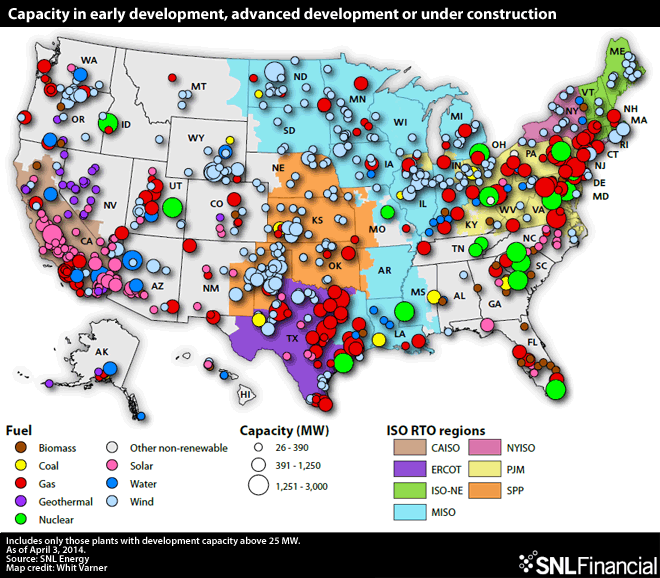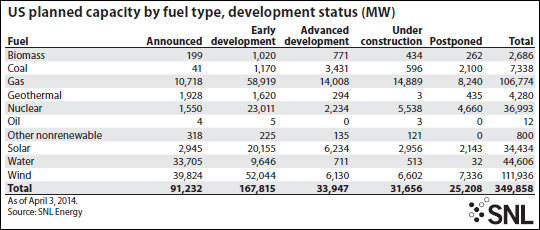 If there was any lingering doubt that the tide has swung away from nuclear power and fossil fuels, consider this: a new report from SNL Financial finds that renewables represent–by a large margin–most of the new electrical generating capacity currently planned to be built in the U.S.
If there was any lingering doubt that the tide has swung away from nuclear power and fossil fuels, consider this: a new report from SNL Financial finds that renewables represent–by a large margin–most of the new electrical generating capacity currently planned to be built in the U.S.
Fully 56.58% of new capacity is to come from renewables, according to the report, with wind making up the majority of the renewable installations. Natural gas comes in second at 30.52%. In total, the report says a total of 349,858 MW of new capacity is planned; wind is the largest single source at 111,936 MW.
The report includes only projects that have reached at least the stage of being announced by utilities, and the large majority of the projects of all fuel types are either in that very initial phase or in what is considered early development. Less than 19% of this proposed new capacity is in either advanced development or actually under construction, meaning that the generation types could change depending on economic and environmental circumstances in coming years.
With that caveat in mind, when we look more closely at the numbers, the news is even better than it may appear.
You see, SNL Financial is relying on and aggregating information provided by utilities–and in some cases that information is either outdated or represented wishful thinking, especially when it comes to nuclear power.
 First, let’s take a look at the graph from the report reproduced immediately above.
First, let’s take a look at the graph from the report reproduced immediately above.
You’ll note that nuclear power is projected for 36,993 MW of new capacity, of which 5,538 MW is under construction. That represents the Vogtle and Summer nuclear projects in Georgia and South Carolina, which are indeed under construction. Then you’ll see 2,234 MW of nuclear projects under “advanced development.” About half of that is likely the Tennessee Valley Authority’s Watts Bar-2 reactor, which TVA is attempting to make the world’s longest construction project–it received its construction permit from the NRC in January 1973. We have no idea what SNL considers as another nuclear project in the U.S. as under “advanced development.” There are none.
Then, note that the vast majority–23,011 MW or about two-thirds-of the supposed new nuclear capacity–is considered in early development, and another 1550 MW is listed as “announced.” Those numbers represent the failed “nuclear renaissance.” Most of those reactors have either already been cancelled or never got off the ground. Only a handful–North Anna in Virginia, Fermi-3 in Michigan, Lee in the Carolinas–are threats for construction, and those are all on shaky ground. But, because the utilities involved have not officially withdrawn their plans, they’re still included.
We can see, from the map at the top of this page, what some of these nuclear projects are: a project in Idaho that never got off the ground; the Green River project in Utah, which officially lumbers on despite having no financing, no market and no license application; Grand Gulf-2 in Mississippi, an Entergy project abandoned years ago; Calvert-Cliffs-3 in Maryland, which was denied a license and has now officially been ended; the Bell Bend Areva EPR in Pennsylvania, which even its backers admitted would cost $15 Billion for a single reactor; a phantom project in southern Ohio, presumably to power USEC’s failed uranium enrichment plant that it wants to build there but can’t because the company is bankrupt; Ameren’s cancelled Callaway-2 reactor in Missouri. In short, nearly all of this supposed new nuclear capacity will never be built.
Then consider this: the report states that some 25,000 MW of coal plants are scheduled to be retired by 2018. That’s great news for everyone concerned about climate change, but it could and should grow even higher. Here’s why: the report only considers retirements already announced by utilities; it doesn’t try to provide its own projections. Thus, for nuclear power, the report includes only those reactors closed last year plus Vermont Yankee, scheduled to close this year. But the odds that all of the aging reactors–more than a dozen currently–confronting the reality that their electricity is more expensive than alternatives will be able to stay open are slim. Indeed, the pace of reactor shutdowns is more likely to accelerate than it is to fall to zero. A number of coal plants in similar markets are in similar situations, and the disparity will only grow as more renewables come online.
Finally, note this: the report is based on utility plans and thus appears to completely ignore rooftop solar. Since rooftop solar usually shows up on utility balance sheets as power not sold (or in some cases, as power purchased when homeowners sell unused power back to the grid) rather than power generated, that makes sense to them. But the rapid rise of rooftop solar–especially as projected over the next several years, is likely to lead, as stated above, to accelerated shutdown of unnecessary and costly nuclear and coal plants.
The map at the top of the page, for example, includes only utility-scale projects of 25 MW or more, meaning that a lot of small solar power plants, in addition to rooftop solar, are not included. However, it is unclear whether the map reflects all new planned capacity or just that above the 25 MW threshhold.
In any case, the gap between renewables and nuclear is growing wider and even the utilities know it, whether they want to admit it or not….
But one entity that seems to not want to admit it is the U.S. government. Ken Bossong of the Sun Day Campaign today warned that the Energy Information Administration is planning to issue its 2014 Annual Energy Outlook next Wednesday, April 30. As Sun Day pointed out last week, EIA in a December preview of the Outlook, projected renewables would grow from 12% of U.S. electricity capacity in 2012 to only 16% by 2040–a projection that is simply not credible given the rapid growth of renewables and the SNL report on planned capacity.
As Bossong states, “We believe this projection does not pass the laugh test. More importantly, it is highly likely that EIA’s projections will be broadly reiterated in the media and risks becoming the accepted basis for future decisions by policy-makers, regulators, investors, and others. Obviously, unrealistically low forecasts provide ammunition for those arguing that investments in renewable energy are not cost-effective and that new fossil fuel and nuclear construction is necessary because renewables cannot meet the nation’s future energy needs. As such, EIA’s projections can have multiple adverse impacts on the renewable energy industry as well as on the nation’s environmental and energy future.”
Because of the criticism EIA has received over that projection, there is at least some small chance it will change its numbers. But it’s a small chance. We’ll let you know as soon as we receive their report–and, if it continues to mislead, an action you can take to help get better projections from our government.
Michael Mariotte
April 23, 2014
Permalink: https://www.nirs.org/2014/04/23/new-report-says-renewables/
You can now support GreenWorld with your tax-deductible contribution on our new donation page here. We gratefully appreciate every donation of any size–your support is what makes our work possible.
Comments are welcome on all GreenWorld posts! Say your piece above. Start a discussion. Don’t be shy; this blog is for you.
If you like GreenWorld, you can help us reach more people. Just use the icons below to “like” our posts and to share them on the various social networking sites you use. And if you don’t like GreenWorld, please let us know that too. Send an e-mail with your comments/complaints/compliments to nirs@nirs.org. Thank you!
Note: If you’d like to receive GreenWorld via e-mail daily, send your name and e-mail address to nirs@nirs.org and we’ll send you an invitation. Note that the invitation will come from a GreenWorld@wordpress.com address and not a nirs.org address, so watch for it.




0 responses to “New report says renewables make up most of planned new U.S. generating capacity–and the reality is even better.”